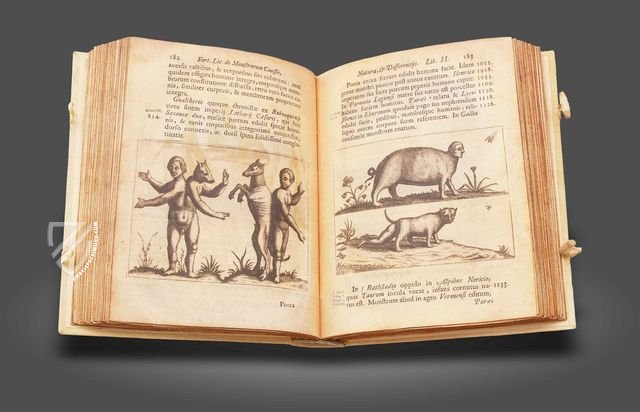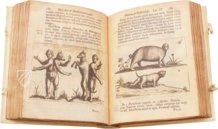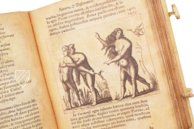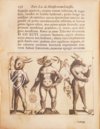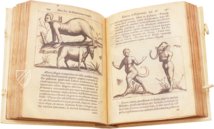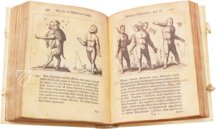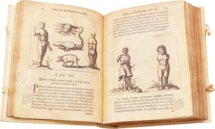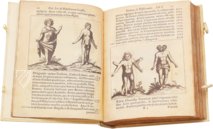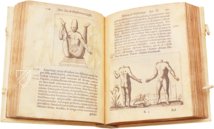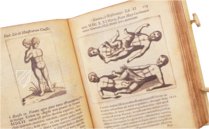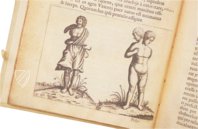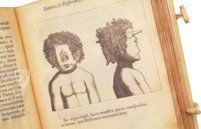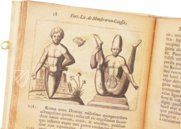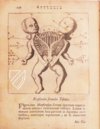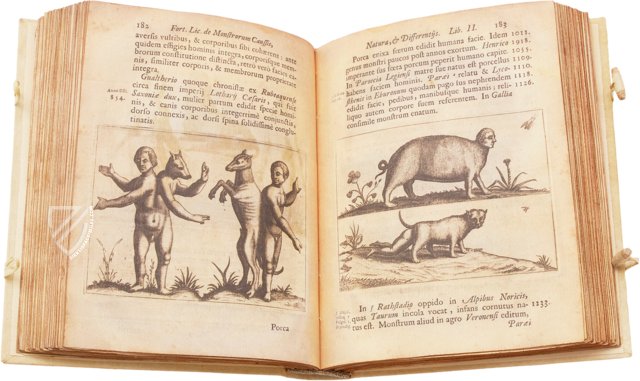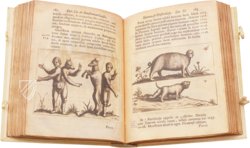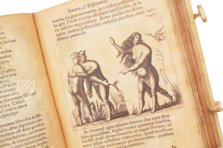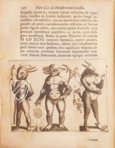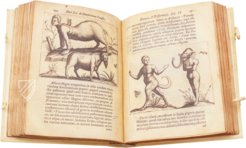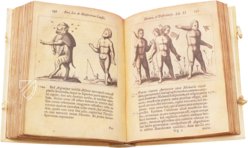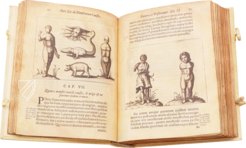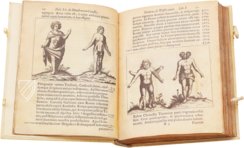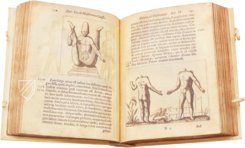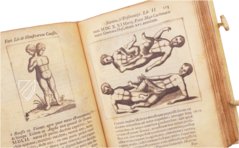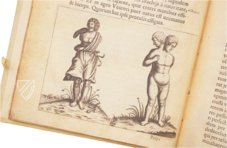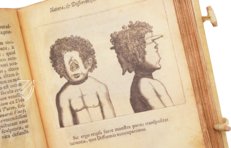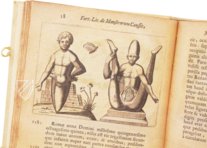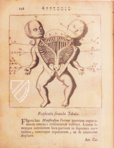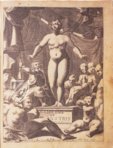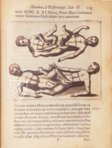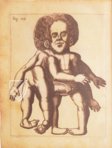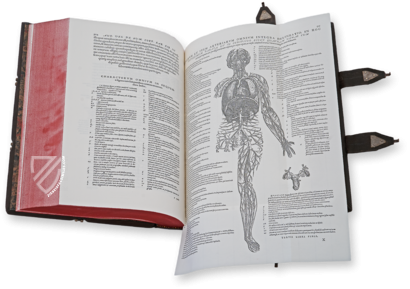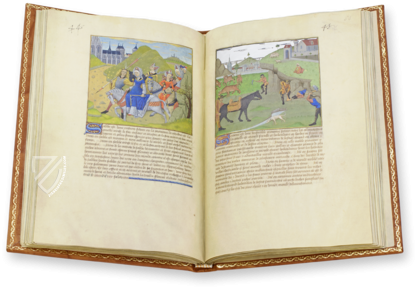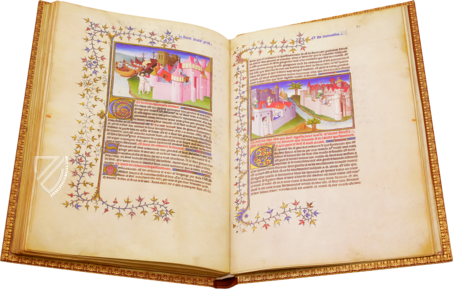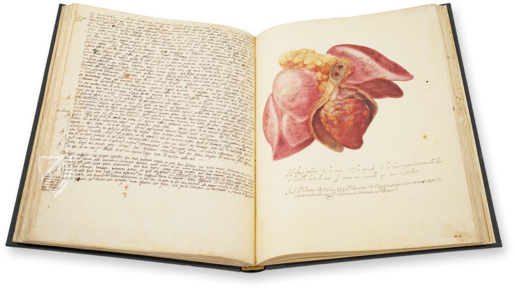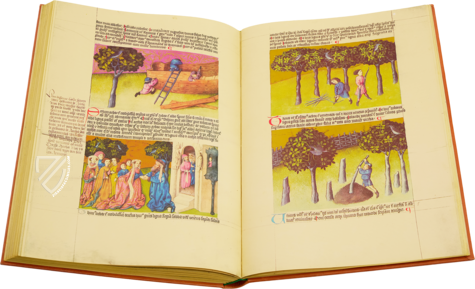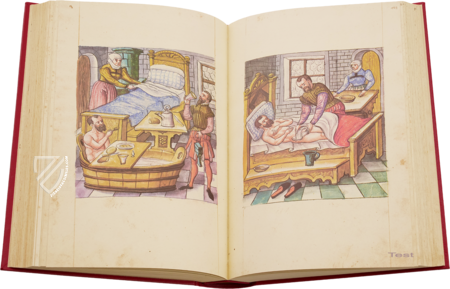De Monstris
(1,000€ - 3,000€)
With De Monstris, Fortunio Liceti made an important contribution to the history of medicine and science. The work, first published in 1616, made a major impact on the dissemination of innovative approaches to explaining physical deformities, which did not merely refer to supernatural fates, but rather sought for biological causes. The 1668 edition of the treatise, published by Paolo Frambotti in Padua, also features 74 high-quality copperplate engravings, probably created by Hendrik Bary. Based on the text, these show not only physical dysplasias, but also wondrous mythical creatures and 'exotic' animal species.
Ancient fascination
Accounts of deformities are as old as human written culture. Already in ancient Babylonia and Greece dysplasias of human bodies were described. Such non-standard body shapes were interpreted as a 'play of nature' or omen until the 16th century, which is why terms like 'monster' and 'monstrosity' were also common in this context.
In the early modern period, however, people were no longer pleased with purely supernatural explanations for the miraculous phenomena and began to search for their causes, which were initially assumed to be in the genome, mechanical impacts on the fetus, and diseases of the same. With the increased interest in the subject, the first publications concerning root cause analysis appeared in the 16th and 17th centuries, of which probably the most influential and widely circulated was Fortunio Liceti's (1577–1657) De Monstrorum Causis, Natura et Diferentiis.
A product of its time
Liceti initially published his most successful and best-known work in 1616 without any illustrations. His treatise, divided into two books and dozens of shorter chapters, however, not only deals with physical deformities in the modern sense, but also includes passages on wondrous mythical creatures and common animal species which were only perceived as exotic and 'abnormal' by the European readership.
Thus, the author linked two extremely popular and much discussed topics of his time. First, it is about the limits of (human) physiognomy and the related idea that the character of the soul is also reflected in the external appearance of the human being. According to this, a deformed physique was at the same time understood as evidence of moral weaknesses or even a corrupted soul, which is based on Pseudo-Aristotle's treatise Physiognomonica. On the other hand, the text is also influenced by the burgeoning Renaissance ethnography that developed from the increasing exploration of the world and the countless tales of the foreign. The growing interest in the inhabitants of non-European regions was accompanied by many prejudices about these 'others', who were subsequently often imagined as 'monsters' or people with physical 'monstrosities'.
Accordingly, Fortunio Liceti's work hit exactly the taste of the time and its widespread reception soon allowed for several (illustrated) reprints, which appeared under the shorter title De Monstris.
Astonishing illustrations
Thus, 1634 saw the first illustrated edition of the text, to which initially 58 copper engravings were added for this purpose, which served as models for later editions. Among these, the one that stands out the most is the edition published 1668 by the printer Paolo Frambotti in Padua and dedicated to the couple Verità and Girolamo Zenobio from an important Veronese family. Its quality and meticulous decoration with fantastic copper engravings immediately catches the eye. The edition, published posthumously by Gerardus Leonardus Blasius (d. 1692), was supplemented by the latter with an Appendix, which additionally contains 15 new illustrations showing famous contemporary cases of malformed bodies that had become known after the dissemination of Liceti's work. The edition is also complemented by a striking title page with a wonderful full-page copper engraving signed by Hendrik Bary (d. 1717), who was probably also responsible for the rest of the illustrations.
A piece of medical and scientific history
Although the work remains attached to Aristotelian doctrines and thus to some assumptions and beliefs of antiquity and the Middle Ages, it nevertheless represents an important step in medical history, as it disseminated new theses on the causes of malformations. This approach, which was quite innovative at the time, and the search for biological explanations as a counterweight to the supernatural attempts at explanation of earlier times makes De Monstris an important work in the history of medicine and science. Together with similar treatises, it forms the foundation of modern scientific teratology.
Codicology
- Alternative Titles
- De monstrorum causis
- Size / Format
- 356 pages / 19.0 × 15.0 cm
- Origin
- Italy
- Date
- 1668
- Epochs
- Style
- Language
- Illustrations
- 74 copperplate illustrations, including one title page
- Content
- Treatise on physical deformities among humans and animals
- Artist / School
- Fortunio Liceti (author)
Paolo Frambotti (printer)
Hendrik Bary (engraver)
De Monstris
The Monster from the Tiber
This copperplate engraving shows three exceptional hybrids, which surpass even ancient and medieval imaginations and myths. The creature on the right is said to have been discovered in the Tiber River in Rome in 1496, according to the text. The depiction corresponds to the description above: The female-shaped body is mostly covered with scales, while the head resembles that of a donkey. The extremities all have different ends - thus the monster has a human hand, an arm stump in the shape of an elephant's foot, a foot with eagle claws and a cloven hoof.
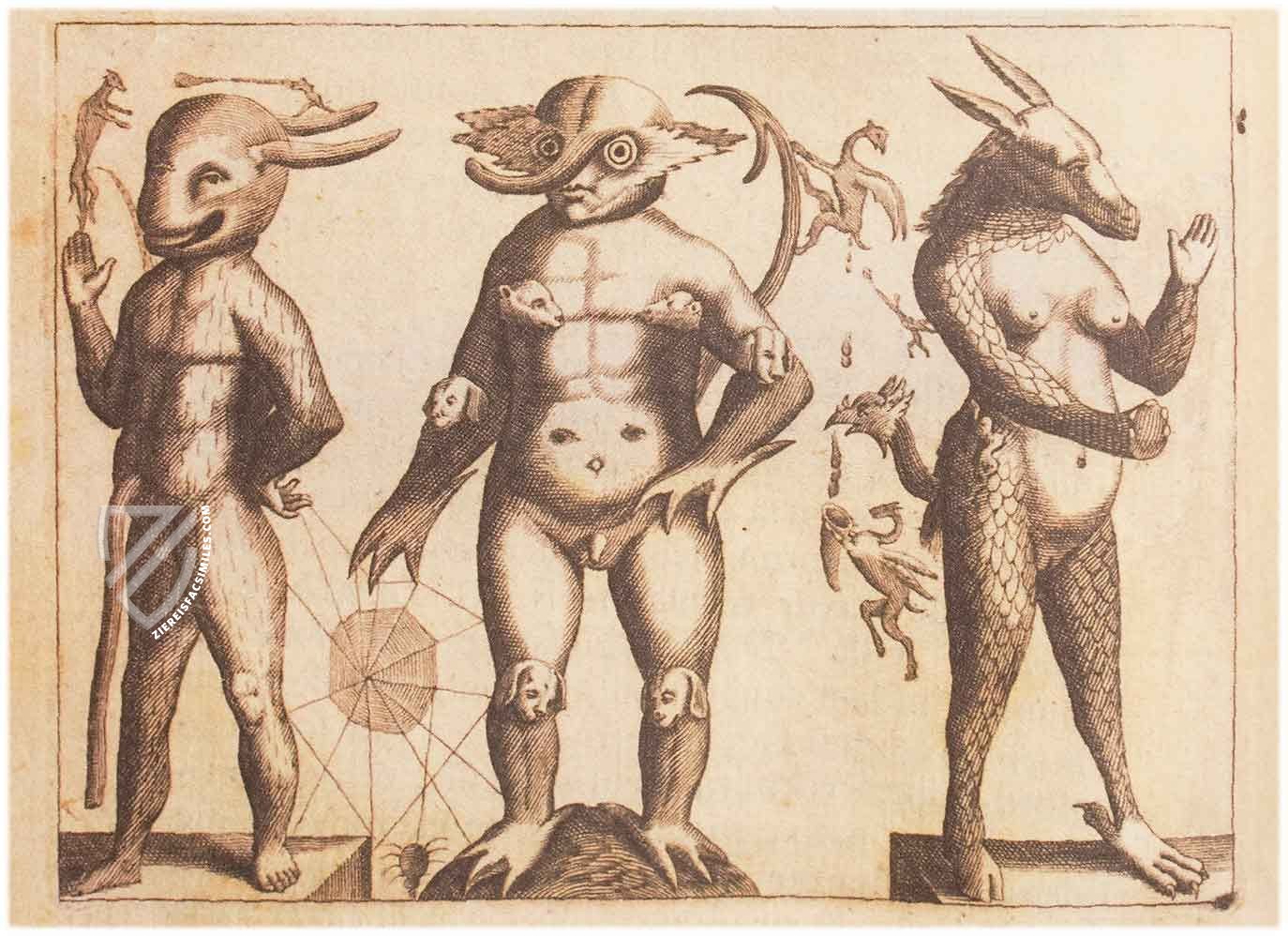
De Monstris
Lazarus and Joannes Baptista Colloredo
The two brothers Lazarus and Joannes Baptista Colloredo were probably the most famous Siamese twins in 17th century Europe. The twins, fused at the abdomen or chest, were born in 1617 into a wealthy Genoese family and were already examined in infancy by various physicians who sought to understand the phenomenon. In the adulthood Lazarus decided to exhibit himself and his brother in numerous European countries, whereby the two could afford a respectable life-style.
That is reflected also in this illustration: The upright standing Lazarus carries an expensive coat over shirt and trousers. The right hand is thereby pressed into the side, which lends to him steadfastness. His brother Joannes Baptista hangs passively and half dressed at his front, while the two arms seem to reach for parts of the clothing and he supports his only foot at Lazarus' knee.
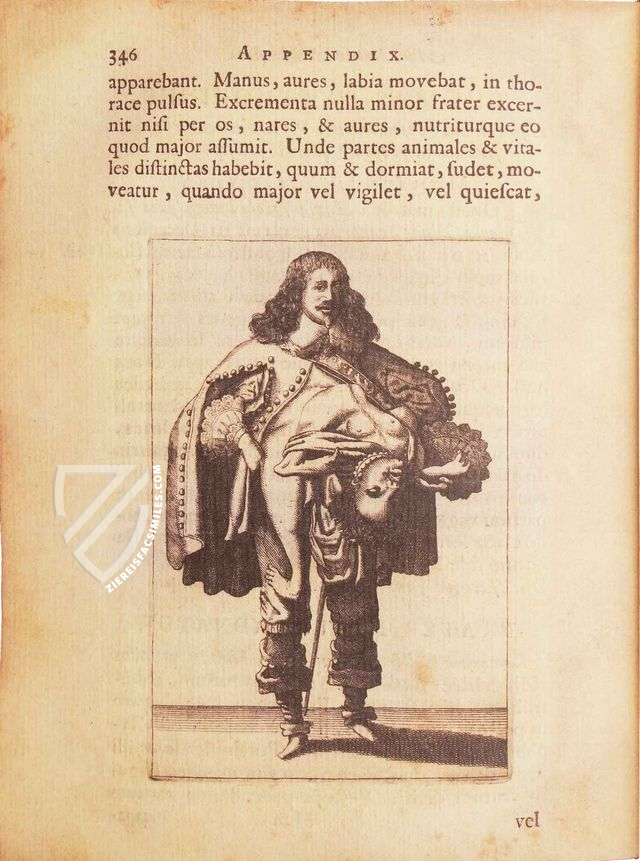
#1 De Monstris
Language: Spanish
(1,000€ - 3,000€)
- Treatises / Secular Books
- Apocalypses / Beatus
- Astronomy / Astrology
- Bestiaries
- Bibles / Gospels
- Chronicles / History / Law
- Geography / Maps
- Saints' Lives
- Islam / Oriental
- Judaism / Hebrew
- Single Leaf Collections
- Leonardo da Vinci
- Literature / Poetry
- Liturgical Manuscripts
- Medicine / Botany / Alchemy
- Music
- Mythology / Prophecies
- Psalters
- Other Religious Books
- Games / Hunting
- Private Devotion Books
- Other Genres
- Afghanistan
- Armenia
- Austria
- Belgium
- Belize
- Bosnia and Herzegovina
- China
- Colombia
- Costa Rica
- Croatia
- Cyprus
- Czech Republic
- Denmark
- Egypt
- El Salvador
- Ethiopia
- France
- Germany
- Greece
- Guatemala
- Honduras
- Hungary
- India
- Iran
- Iraq
- Israel
- Italy
- Japan
- Jordan
- Kazakhstan
- Kyrgyzstan
- Lebanon
- Liechtenstein
- Luxembourg
- Mexico
- Morocco
- Netherlands
- Palestine
- Panama
- Peru
- Poland
- Portugal
- Romania
- Russia
- Serbia
- Spain
- Sri Lanka
- Sweden
- Switzerland
- Syria
- Tajikistan
- Turkey
- Turkmenistan
- Ukraine
- United Kingdom
- United States
- Uzbekistan
- Vatican City
- A. Oosthoek, van Holkema & Warendorf
- Aboca Museum
- Ajuntament de Valencia
- Akademie Verlag
- Akademische Druck- u. Verlagsanstalt (ADEVA)
- Aldo Ausilio Editore - Bottega d’Erasmo
- Alecto Historical Editions
- Alkuin Verlag
- Almqvist & Wiksell
- Amilcare Pizzi
- Andreas & Andreas Verlagsbuchhandlung
- Archa 90
- Archiv Verlag
- Archivi Edizioni
- Arnold Verlag
- ARS
- Ars Magna
- ArtCodex
- AyN Ediciones
- Azimuth Editions
- Badenia Verlag
- Bärenreiter-Verlag
- Belser Verlag
- Belser Verlag / WK Wertkontor
- Benziger Verlag
- Bernardinum Wydawnictwo
- BiblioGemma
- Biblioteca Apostolica Vaticana (Vaticanstadt, Vaticanstadt)
- Bibliotheca Palatina Faksimile Verlag
- Bibliotheca Rara
- Boydell & Brewer
- Bramante Edizioni
- Bredius Genootschap
- Brepols Publishers
- British Library
- C. Weckesser
- Caixa Catalunya
- Canesi
- CAPSA, Ars Scriptoria
- Caratzas Brothers, Publishers
- Carus Verlag
- Casamassima Libri
- Centrum Cartographie Verlag GmbH
- Chavane Verlag
- Christian Brandstätter Verlag
- Circulo Cientifico
- Club Bibliófilo Versol
- Club du Livre
- CM Editores
- Collegium Graphicum
- Collezione Apocrifa Da Vinci
- Comissão Nacional para as Comemorações dos Descobrimentos Portugueses
- Coron Verlag
- Corvina
- CTHS
- D. S. Brewer
- Damon
- De Agostini/UTET
- De Nederlandsche Boekhandel
- De Schutter
- Deuschle & Stemmle
- Deutscher Verlag für Kunstwissenschaft
- DIAMM
- Droz
- E. Schreiber Graphische Kunstanstalten
- Ediciones Boreal
- Ediciones Grial
- Ediclube
- Edições Inapa
- Edilan
- Editalia
- Edition Deuschle
- Edition Georg Popp
- Edition Leipzig
- Edition Libri Illustri
- Editiones Reales Sitios S. L.
- Éditions de l'Oiseau Lyre
- Editions Medicina Rara
- Editorial Casariego
- Editorial Mintzoa
- Editrice Antenore
- Editrice Velar
- Edizioni Edison
- Egeria, S.L.
- Eikon Editores
- Electa
- Emery Walker Limited
- Enciclopèdia Catalana
- Eos-Verlag
- Ephesus Publishing
- Ernst Battenberg
- Eugrammia Press
- Extraordinary Editions
- Fackelverlag
- Facsimila Art & Edition
- Facsimile Editions Ltd.
- Facsimilia Art & Edition Ebert KG
- Faksimile Verlag
- Feuermann Verlag
- Folger Shakespeare Library
- Franco Cosimo Panini Editore
- Friedrich Wittig Verlag
- Fundación Hullera Vasco-Leonesa
- G. Braziller
- Gabriele Mazzotta Editore
- Gebr. Mann Verlag
- Gesellschaft für graphische Industrie
- Getty Research Institute
- Giovanni Domenico de Rossi
- Giunti Editore
- Graffiti
- Grafica European Center of Fine Arts
- Guido Pressler
- Guillermo Blazquez
- Gustav Kiepenheuer
- H. N. Abrams
- Harrassowitz
- Harvard University Press
- Helikon
- Hendrickson Publishers
- Henning Oppermann
- Herder Verlag
- Hes & De Graaf Publishers
- Hoepli
- Holbein-Verlag
- Houghton Library
- Hugo Schmidt Verlag
- Idion Verlag
- Il Bulino, edizioni d'arte
- ILte
- Imago
- Insel Verlag
- Insel-Verlag Anton Kippenberger
- Instituto de Estudios Altoaragoneses
- Instituto Nacional de Antropología e Historia
- Introligatornia Budnik Jerzy
- Istituto dell'Enciclopedia Italiana - Treccani
- Istituto Ellenico di Studi Bizantini e Postbizantini
- Istituto Geografico De Agostini
- Istituto Poligrafico e Zecca dello Stato
- Italarte Art Establishments
- Jan Thorbecke Verlag
- Johnson Reprint Corporation
- Josef Stocker
- Josef Stocker-Schmid
- Jugoslavija
- Karl W. Hiersemann
- Kasper Straube
- Kaydeda Ediciones
- Kindler Verlag / Coron Verlag
- Kodansha International Ltd.
- Konrad Kölbl Verlag
- Kurt Wolff Verlag
- La Liberia dello Stato
- La Linea Editrice
- La Meta Editore
- Lambert Schneider
- Landeskreditbank Baden-Württemberg
- Leo S. Olschki
- Les Incunables
- Liber Artis
- Library of Congress
- Libreria Musicale Italiana
- Lichtdruck
- Lito Immagine Editore
- Lumen Artis
- Lund Humphries
- M. Moleiro Editor
- Maison des Sciences de l'homme et de la société de Poitiers
- Manuscriptum
- Martinus Nijhoff
- Maruzen-Yushodo Co. Ltd.
- MASA
- Massada Publishers
- McGraw-Hill
- Metropolitan Museum of Art
- Militos
- Millennium Liber
- Müller & Schindler
- Nahar - Stavit
- Nahar and Steimatzky
- National Library of Wales
- Neri Pozza
- Nova Charta
- Oceanum Verlag
- Odeon
- Orbis Mediaevalis
- Orbis Pictus
- Österreichische Staatsdruckerei
- Oxford University Press
- Pageant Books
- Parzellers Buchverlag
- Patrimonio Ediciones
- Pattloch Verlag
- PIAF
- Pieper Verlag
- Plon-Nourrit et cie
- Poligrafiche Bolis
- Presses Universitaires de Strasbourg
- Prestel Verlag
- Princeton University Press
- Prisma Verlag
- Priuli & Verlucca, editori
- Pro Sport Verlag
- Propyläen Verlag
- Pytheas Books
- Quaternio Verlag Luzern
- Reales Sitios
- Recht-Verlag
- Reichert Verlag
- Reichsdruckerei
- Reprint Verlag
- Riehn & Reusch
- Roberto Vattori Editore
- Rosenkilde and Bagger
- Roxburghe Club
- Salerno Editrice
- Saltellus Press
- Sandoz
- Sarajevo Svjetlost
- Schöck ArtPrint Kft.
- Schulsinger Brothers
- Scolar Press
- Scrinium
- Scripta Maneant
- Scriptorium
- Shazar
- Siloé, arte y bibliofilia
- SISMEL - Edizioni del Galluzzo
- Sociedad Mexicana de Antropología
- Société des Bibliophiles & Iconophiles de Belgique
- Soncin Publishing
- Sorli Ediciones
- Stainer and Bell
- Studer
- Styria Verlag
- Sumptibus Pragopress
- Szegedi Tudomànyegyetem
- Taberna Libraria
- Tarshish Books
- Taschen
- Tempus Libri
- Testimonio Compañía Editorial
- Thames and Hudson
- The Clear Vue Publishing Partnership Limited
- The Facsimile Codex
- The Folio Society
- The Marquess of Normanby
- The Richard III and Yorkist History Trust
- Tip.Le.Co
- TouchArt
- TREC Publishing House
- TRI Publishing Co.
- Trident Editore
- Tuliba Collection
- Typis Regiae Officinae Polygraphicae
- Union Verlag Berlin
- Universidad de Granada
- University of California Press
- University of Chicago Press
- Urs Graf
- Vallecchi
- Van Wijnen
- VCH, Acta Humaniora
- VDI Verlag
- VEB Deutscher Verlag für Musik
- Verlag Anton Pustet / Andreas Verlag
- Verlag Bibliophile Drucke Josef Stocker
- Verlag der Münchner Drucke
- Verlag für Regionalgeschichte
- Verlag Styria
- Vicent Garcia Editores
- W. Turnowski Ltd.
- W. Turnowsky
- Waanders Printers
- Wiener Mechitharisten-Congregation (Wien, Österreich)
- Wissenschaftliche Buchgesellschaft
- Wissenschaftliche Verlagsgesellschaft
- Wydawnictwo Dolnoslaskie
- Xuntanza Editorial
- Zakład Narodowy
- Zollikofer AG

